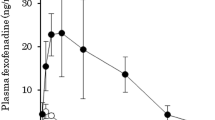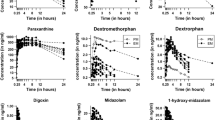Abstract
Purpose
Piperine (PIP) has been found to inhibit P-glycoprotein (P-gp) function in rats, suggesting that it may have the potential to modulate P-gp-mediated drug efflux in humans. The aim of this study was to evaluate the effect of PIP on the pharmacokinetics of fexofenadine (FEX), a P-gp substrate, in healthy volunteers.
Methods
An open-label, two-period, sequential study involving 12 healthy volunteers was conducted. A single oral dose of FEX 120 mg was given to volunteers during the control phase and after the treatment phase. A once-daily oral dose of PIP 20 mg was given to volunteers during the treatment phase (10 days). Blood samples were collected at predefined time intervals, and plasma samples containing FEX were analyzed by liquid chromatography-tandem mass spectrometry.
Results
Treatment with PIP significantly increased maximum plasma concentration of FEX [406.9 (control) vs. 767 ng/mL (treatment)] and area under the plasma concentration–time curve [3403.7 (control) vs. 5724.7 ng.h/mL (treatment)] when compared to the control phase. In contrast, PIP treatment significantly decreased apparent oral clearance of FEX [35.4 (control) vs. 20.7 L/h (treatment)] as compared to the control. There was no significant change observed in the half life and renal clearance of FEX between the treatment phase and control phase.
Conclusions
The results suggest that altered pharmacokinetics and enhanced bioavailability of FEX might be attributed to PIP-mediated inhibition of P-gp drug efflux. Therefore, intake of PIP or dietary supplements containing PIP may potentially enhance the absorption or bioavailability of P-gp substrate drugs in addition to FEX.

Similar content being viewed by others
References
Wilkinson GR (1997) The effects of diet, aging and disease-states on presystemic elimination and oral drug bioavailability in humans. Adv Drug Deliv Rev 27:129–159
Evans AM (2000) Influence of dietary components on the gastrointestinal metabolism and transport of drugs. Ther Drug Monit 22:131–136
Srinivasan K (2007) Black pepper and its pungent principle-piperine: a review of diverse physiological effects. Crit Rev Food Sci Nutr 47:735–748
Meghwal M, Goswami TK (2013) Piper nigrum and piperine: an update. Phytother Res 27:1121–1130
Bano G, Amla V, Raina RK, Zutshi U, Chopra CL (1987) The effect of piperine on pharmacokinetics of phenytoin in healthy volunteers. Planta Med 53:568–569
Velpandian T, Jasuja R, Bhardwaj RK, Jaiswal J, Gupta SK (2001) Piperine in food: interference in the pharmacokinetics of phenytoin. Eur J Drug Metab Pharmacokinet 26:241–247
Pattanaik S, Hota D, Prabhakar S, Kharbanda P, Pandhi P (2006) Effect of piperine on the steady-state pharmacokinetics of phenytoin in patients with epilepsy. Phytother Res 20:683–686
Pattanaik S, Hota D, Prabhakar S, Kharbanda P, Pandhi P (2009) Pharmacokinetic interaction of single dose of piperine with steady-state carbamazepine in epilepsy patients. Phytother Res 23:1281–1286
Rezaee MM, Kazemi S, Kazemi MT, Gharooee S, Yazdani E, Gharooee H et al (2014) The effect of piperine on midazolam plasma concentration in healthy volunteers, a research on the CYP3A-involving metabolism. Daru 22:8
Bano G, Raina RK, Zutshi U, Bedi KL, Johri RK, Sharma SC (1991) Effect of piperine on bioavailability and pharmacokinetics of propranolol and theophylline in healthy volunteers. Eur J Clin Pharmacol 41:615–617
Han Y, Chin Tan TM, Lim LY (2008) In vitro and in vivo evaluation of the effects of piperine on P-gp function and expression. Toxicol Appl Pharmacol 230:283–289
Han HK (2011) The effects of black pepper on the intestinal absorption and hepatic metabolism of drugs. Expert Opin Drug Metab Toxicol 7:721–729
Koul S, Koul JL, Taneja SC, Dhar KL, Jamwal DS, Singh K et al (2000) Structure-activity relationship of piperine and its synthetic analogues for their inhibitory potentials of rat hepatic microsomal constitutive and inducible cytochrome P450 activities. Bioorg Med Chem 8:251–268
Atal CK, Dubey RK, Singh J (1985) Biochemical basis of enhanced drug bioavailability by piperine: evidence that piperine is a potent inhibitor of drug metabolism. J Pharmacol Exp Ther 232:258–262
Volak LP, Ghirmai S, Cashman JR, Court MH (2008) Curcuminoids inhibit multiple human cytochromes P450, UDP-glucuronosyltransferase, and sulfotransferase enzymes, whereas piperine is a relatively selective CYP3A4 inhibitor. Drug Metab Dispos 36:1594–1605
Bhardwaj RK, Glaeser H, Becquemont L, Klotz U, Gupta SK, Fromm MF (2002) Piperine, a major constituent of black pepper, inhibits human P-glycoprotein and CYP3A4. J Pharmacol Exp Ther 302:645–650
Alhumayyd MS, Bukhari IA, Almotrefi AA (2014) Effect of piperine, a major component of black pepper, on the pharmacokinetics of domperidone in rats. J Physiol Pharmacol 65:785–789
Jin MJ, Han HK (2010) Effect of piperine, a major component of black pepper, on the intestinal absorption of fexofenadine and its implication on food–drug interaction. J Food Sci 75:H93–H96
Simpson K, Jarvis B (2000) Fexofenadine: a review of its use in the management of seasonal allergic rhinitis and chronic idiopathic urticaria. Drugs 59:301–321
Kim KA, Park PW, Park JY (2009) Short-term effect of quercetin on the pharmacokinetics of fexofenadine, a substrate of P-glycoprotein, in healthy volunteers. Eur J Clin Pharmacol 65:609–614
Drescher S, Schaeffeler E, Hitzl M, Hofmann U, Schwab M, Brinkmann U (2002) MDR1 gene polymorphisms and disposition of the P-glycoprotein substrate fexofenadine. Br J Clin Pharmacol 53:526–534
Cvetkovic M, Leake B, Fromm MF, Wilkinson GR, Kim RB (1999) OATP and P-glycoprotein transporters mediate the cellular uptake and excretion of fexofenadine. Drug Metab Dispos 27:866–871
Niemi M, Kivisto KT, Hofmann U, Schwab M, Eichelbaum M, Fromm MF (2005) Fexofenadine pharmacokinetics are associated with a polymorphism of the SLCO1B1 gene (encoding OATP1B1). Br J Clin Pharmacol 59:602–604
Shimizu M, Fuse K, Okudaira K, Nishigaki R, Maeda K, Kusuhara H et al (2005) Contribution of OATP (organic anion-transporting polypeptide) family transporters to the hepatic uptake of fexofenadine in humans. Drug Metab Dispos 33:1477–1481
Nozawa T, Imai K, Nezu J, Tsuji A, Tamai I (2004) Functional characterization of pH-sensitive organic anion transporting polypeptide OATP-B in human. J Pharmacol Exp Ther 308:438–445
Yasui-Furukori N, Uno T, Sugawara K, Tateishi T (2005) Different effects of three transporting inhibitors, verapamil, cimetidine, and probenecid, on fexofenadine pharmacokinetics. Clin Pharmacol Ther 77:17–23
Shimizu M, Uno T, Sugawara K, Tateishi T (2006) Effects of itraconazole and diltiazem on the pharmacokinetics of fexofenadine, a substrate of P-glycoprotein. Br J Clin Pharmacol 61:538–544
van Heeswijk RP, Bourbeau M, Campbell P, Seguin I, Chauhan BM, Foster BC et al (2006) Time-dependent interaction between lopinavir/ritonavir and fexofenadine. J Clin Pharmacol 46:758–767
Ambudkar SV, Dey S, Hrycyna CA, Ramachandra M, Pastan I, Gottesman MM (1999) Biochemical, cellular, and pharmacological aspects of the multidrug transporter. Annu Rev Pharmacol Toxicol 39:361–398
Thiebaut F, Tsuruo T, Hamada H, Gottesman MM, Pastan I, Willingham MC (1987) Cellular localization of the multidrug-resistance gene product P-glycoprotein in normal human tissues. Proc Natl Acad Sci USA 84:7735–7738
Fromm MF (2000) P-glycoprotein: a defense mechanism limiting oral bioavailability and CNS accumulation of drugs. Int J Clin Pharmacol Ther 38:69–74
Bedada SK, Yakkanti SA, Neerati P (2014) Resveratrol enhances the bioavailability of fexofenadine in healthy human male volunteers: involvement of P-glycoprotein inhibition. J Bioequiv Availab 6:158–163
Guo D, Zou J, Zhu Y, Lou S, Fan H, Qin Q (2010) Measurement of fexofenadine concentration in micro-sample human plasma by a rapid and sensitive LC-MS/MS employing protein precipitation: application to a clinical pharmacokinetic study. Biomed Chromatogr 24:335–341
Perloff MD, von Moltke LL, Greenblatt DJ (2002) Fexofenadine transport in Caco-2 cells: inhibition with verapamil and ritonavir. J Clin Pharmacol 42:1269–1274
Petri N, Tannergren C, Rungstad D, Lennernäs H (2004) Transport characteristics of fexofenadine in the Caco-2 cell model. Pharm Res 21:1398–1404
Khajuria A, Thusu N, Zutshi U (2002) Piperine modulates permeability characteristics of intestine by inducing alterations in membrane dynamics: influence on brush border membrane fluidity, ultrastructure and enzyme kinetics. Phytomedicine 9:224–231
Khajuria A, Zutshi U, Bedi KL (1998) Permeability characteristics of piperine on oral absorption—an active alkaloid from peppers and a bioavailability enhancer. Indian J Exp Biol 36:46–50
Akamine Y, Miura M, Komori H, Saito S, Kusuhara H, Tamai I et al (2014) Effects of one-time apple juice ingestion on the pharmacokinetics of fexofenadine enantiomers. Eur J Clin Pharmacol 70:1087–1095
Acknowledgements
Satish Kumar Bedada acknowledges the University Grants Commission (UGC), New Delhi, India for financial support to carry out this research work.
Author information
Authors and Affiliations
Corresponding author
Ethics declarations
The protocol was approved by an institutional human ethical committee and was conducted in compliance with the ethical principles from the Declaration of Helsinki and with all International Conference on Harmonisation Good Clinical Practice Guidelines. Informed consent was obtained from all the volunteers included in the study.
Conflict of interest
The authors declare that there are no conflicts of interest.
Rights and permissions
About this article
Cite this article
Bedada, S.K., Boga, P.K. The influence of piperine on the pharmacokinetics of fexofenadine, a P-glycoprotein substrate, in healthy volunteers. Eur J Clin Pharmacol 73, 343–349 (2017). https://doi.org/10.1007/s00228-016-2173-3
Received:
Accepted:
Published:
Issue Date:
DOI: https://doi.org/10.1007/s00228-016-2173-3




